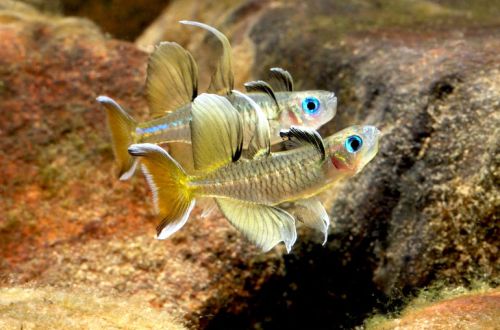
Six Stripe Panhax
Six-banded Panhax or Epiplatis six-banded, scientific name Epiplatys sexfasciatus, belongs to the Nothobranchiidae family. One of the few representatives of Killy fish, which feels great in a mixed flock (males and females together), usually males are very belligerent towards each other. A group of these beautiful creatures will decorate any freshwater aquarium, they are unpretentious and friendly. Maintenance is within the power of even aquarists with little experience.

Contents
Habitat
A representative of the African continent, inhabits water bodies in areas of grassy savannah and tropical forests on the territory of modern Gabon, Equatorial Guinea, Ghana, Cameroon, and Nigeria. They live in freshwater swamps and small tributaries of larger rivers, they are also found in some lakes.
Description
Males are noticeably larger than females, reach 7 cm in length, and have a bright color, mostly pink. A characteristic feature is the six vertical stripes inherent in both sexes. The dorsal and anal fins are shifted closer to the tail, a similar structure hints at a predatory lifestyle.
Food
In nature, a miniature predator, feeds mainly on aquatic and terrestrial invertebrates. The aquarium will accept dried or frozen/live foods of a suitable size, such as daphnia, bloodworms, brine shrimp, grindal worms. It is possible to include small insects in the diet, such as fruit flies, mosquitoes, etc., however, before this, it is advisable to serve dry flakes with herbal ingredients for better digestion, otherwise there is a high risk of constipation.
Maintenance and care
A flock of fish needs a lot of free space, a tank volume of 100 liters or more is considered the minimum. Decoration similar to natural habitat is preferred and includes ubiquitous roots and branches of trees, various snags, vegetation patches of rooting and floating plants. The substrate is sandy with the addition of a few dry leaves, they emphasize the natural look, and also introduce humic substances natural for Epiplatis six-lane into the water. The leaves are renewed every 1-2 weeks to prevent their excessive decomposition.
The set of equipment includes a heating, lighting, aeration and filtration system. As for the filter, it should provide good cleaning, but at the same time create as little water flow as possible, since the fish come from stagnant water bodies and do not respond well to currents. In the case of the popular internal filter cups, the outlet streams can be directed against an obstacle to break the water jet.
Water conditions are typical for most bogs, pH and dGH are slightly acidic and mild, respectively. When filling the aquarium and further updating the water, you will need to monitor these indicators, since tap water has other values. Read more about pH and dGH values, as well as how to change them, in the “Hydrochemical composition of water” section.
Maintenance comes down to regular renewal of part of the water with fresh water (10–15% of the volume) and periodic cleaning of the soil from waste products and other organic matter. As necessary, clean the inner surface of the glass from plaque.
Behavior and Compatibility
An active peaceful friendly species, gets along well with other fish of similar size and temperament. The content is schooling from 6 individuals, males do not conflict with each other even during the spawning period, which is a very rare occurrence among Killy fish.
Breeding / breeding
Spawning at home is quite simple, adult fish give birth regularly, even in a common aquarium. The best results are achieved in a separate tank where spawning takes place and fry develop. The spawning aquarium should contain thickets of plants such as riccia, java moss and the like. From the equipment a simple sponge filter, a heater and a lamp. The composition of the water is identical to the general aquarium.
When you notice that the abdomen of females/females is swollen, and the males have changed their behavior, show attention to the rounded female, and their coloring has become more saturated, then the mating season has begun. The female is placed in a spawning aquarium, the next day a couple of males are attached. After some time, the female lays her eggs in the thickets of plants, and the males fertilize her. This may take several days, remember to feed the fish and renew some of the water with fresh water, as it quickly becomes dirty in a small tank. At the end of spawning, parents are returned to the general aquarium in order to avoid eating their own offspring.
The fry appear after 12-14 days, feed on microorganisms such as Artemia nauplii, shoe ciliates.
Fish diseases
Hereditary diseases are not noticed. The main cause of problems is unsuitable living conditions and poor nutrition, with all recommendations being followed, there are no health problems. Read more about symptoms and treatments in the Aquarium Fish Diseases section.





